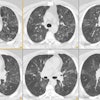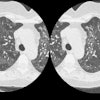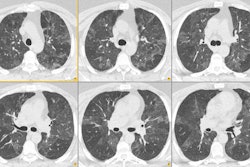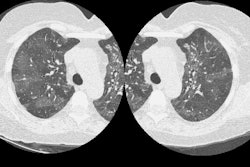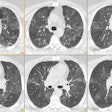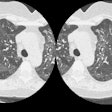MRI of the Thorax and Heart:
Spin Echo Imaging
Spin echo (SE) imaging is most commonly used for evaluation of the chest. The SE sequence uses two radiofrequency pulses to generate an MR signal. The first pulse excites the protons, while the second pulse (following a brief delay) refocuses the protons to produce a coherent signal. The repetition time (TR) and echo time (TE) are used to affect the image appearance relative to T1 and T2 . The TE affects image intensity relative to T2 which is a measurement of the rate at which the MR signal decreases from a maximum value. If an image is obtained with a long TE (i.e.: 60-80 msec) the signal from tissue with a short T2 value decays significantly, while the signal from a tissue with a long T2 decreases to a lesser degree and is therefore stronger. The resultant image is said to be T2 weighted. When a short TE is used, differences in the amount of decay between the two tissues is minimized and the image becomes T2 independent.
The TR value (which is the time between RF pulses) affects the T1 properties of the image. T1 is a measurement of the rate at which nuclei align themselves with the external magnetic field after the RF pulse. When a short TR is used, tissues with a long T1 do not have sufficient time to realign themselves with the external magnetic field before another RF pulse occurs. Because of this, their signal will decrease in strength relative to tissues with a short T1. Short TR images are therefore said to be T1 weighted and images with a long TR are T1 independent.
K-space refers to the storage area where MRI image data is held before it is converted into an image. K-space is composed of phase domain and frequency domain information relating to the data received from the protons within each pixel of the imaging plane. This data is then mathematically manipulated, primarily through Fourier transformation, and reconstructed into an image corresponding to the physical structures. To generate a 256 x 256 matrix image, 256 phase encoding steps are required.
Conventional spin echo sequences yield minimal signal intensity from normal, inflated lung parenchyma because of low proton density, large susceptibility induced magnetic field gradients, and physiologic motion. Motion results in phase changes which are incorrectly ascribed to the phase encoding gradient. As a result, any motion leads to a signal misregistration in the phase encoding direction. Respiratory motion produces a series of ghost images that are seen extending through the image oriented along the phase encoding direction. Respiratory gating has not proven to be of much clinical value due to the significant increase in imaging time. Various software strategies have been developed to reduce respiratory motion artifacts with variable effect on scan time.
Conventional spin echo images result in the absence of signal from flowing blood (dark blood). This flow void is due to time of flight effects and varies with the TE. For long TE's (greater than twice the blood transit time through the slice) the blood leaves the slice before experiencing the second pulse in the SE sequence so that no signal is generated. For short TE's the blood may remain in the section being imaged sufficiently long to experience both RF pulses and therefore produce a signal. The threshold TE above which there will be a flow void is about 20-25 msec. This translates to a flow rate of about 15 centimeters/sec. In situations where flow rates are very slow (such as an aneurysm) a flow void may be generated by exciting the protons prior to entering the image section so as not to generate a signal when they are within the imaged slice - this is referred to as "presaturation."
Metallic artifact is generally less severe on conventional spin echo images compared to gradient echo images where significant "blooming" artifacts are common.
Gating to the ECG enhances image resolution as a result of decreased blurring. The TR value is determined by the heart rate (e.g., a patient with a heart rate of 60 would have a TR of 1000 msec). It has been found that flowing blood with a velocity greater than 10 to 15 cm/sec typically demonstrates no significant MR signal - therefore, usually there is no signal from the lumina of the pulmonary arteries or veins during systole. Intermediate or high signal can be seen within the pulmonary arteries and veins during diastole related to slow or stagnant flow within that portion of the cardiac cycle. During systole, the pulmonary arteries usually have signal void, however, in patients with pulmonary hypertension, increased signal may also occur during systole secondary to slow flow. Increased signal within pulmonary vessels during systole has been found in 92% of patients with pulmonary hypertension, and in all patients with a pulmonary systolic pressure greater than 80 mm Hg (1).
Gradient Echo Imaging:
The gradient echo technique uses a single RF pulse to produce an echo signal. Following excitation by the RF pulse a magnetic field gradient is used to focus the protons to produce an MR signal (referred to as a gradient echo). Typically, gradient echoes are obtained at TE's of 4-12 msec, and can be repeated (TR) about every 20 msec. Gradient echo images produce images with bright signal from rapidly flowing blood. When gated to the ECG, gradient echoes can be acquired at intervals of 20-50 msec throughout the cardiac cycle, and the resultant series of images may be looped electronically forming the basis of "cine-MRI".
The signal from flowing blood can be further enhanced by a technique known as "flow compensation." This technique uses gradient pulses which are adjusted to eliminate motion induced spin incoherence. The improved spin coherence results in less motion and flow artifact and hence, greater signal from the flowing blood. Normal intracardiac and vascular flow is bright, although variably, throughout the cardiac cycle. While flow compensation produces images with brighter, more homogeneous signal from flowing blood, it may also blunt the areas of signal loss seen in regions of turbulent flow related to regurgitant jets, atrial or ventricular septal defects, and shunts. As a result, cine-gradient echo sequences without flow compensation may be more useful to fully evaluate regions of turbulent flow.
Fast Gradient Echo Imaging:
Rapid scanning techniques such as GRASS or FLASH employ low flip angles, gradient refocused echoes, and short TR's and TE's to obtain multiple images during a single breath hold. Flowing blood has a very high signal on GRASS images. ECG gating of GRASS images to the cardiac cycle can produce a cine format image similar to a nuclear medicine MUGA exam. To obtain cine images, the gradient echo sequence is repeated at 20-30 msec intervals to image one or more slices throughout the cardiac cycle. For a typical R-R interval of 750 msec, the sequence may be executed about 30 times so that a single cardiac slice can be imaged at 30 successive phases of the cardiac cycle thus producing 30 separate frames. Alternatively, two slices may be imaged at 15 phases of the cardiac cycle. Data for each individual frame is obtained each cardiac cycle. Since one line of K-space is acquired for each frame per heart beat, and each line is acquired twice and averaged to improve the signal to noise ratio, a typical single scan time is 256 heart beats or about 3 to 4 minutes. By repeating the scan to image a different pair of slices, a complete study can be acquired in about 10-15 minutes.
Gradient Echo Imaging with K-space Segmentation:
Cine images of a single heart slice can now be obtained in about 20 seconds. A gradient echo sequence is utilized with a very short TE of about 2 to 4 msec repeated (TR) every 5 to 10 msec (the TE and TR are usually the minimum values achievable by the MR gradient system so that these parameters may be automatically set by the system software. A flip angle of 10 to 15 degrees is utilized. The acquisition parameters result in saturation of background and stationary tissues, whereas inflowing blood with unsaturated spins have a higher signal intensity (flow related enhancement). During each heartbeat the R-R interval of the cardiac cycle is divided into multiple cine frames typically of 20 to 80 msec duration. The field of view is adjusted to avoid wrap around artifacts. The matrix size is typically 256 in the frequency direction and 128 in the phase direction. A torso pahsed-array surface coil is preferred for the receiver coil.
The major improvement in speed results from acquiring multiple lines of image data for each frame per heart beat, as opposed to a single line (i.e.: K-space or raw data is acquired in multi-line segments as opposed to one data line per heart cycle). This is accomplished by acquiring information for only a small number of frames per cardiac cycle rather than for all the frames. Once enough data for that portion of the cardiac cycle has been acquired, another portion will be sampled. The number of lines of k-space acquired over the duration of a cine frame is referred to as the number of views per segment. The temporal resolution of these studies is often less such that only about 10 phases of the cardiac cycle are obtained. The primary limitation of segmented K-space acquisition is the reduced signal to noise ratio that is due to the short TR and low flip angle. However, motion artifacts (both cardiac and respiratory) which are eliminated by this technique due to breath hold imaging. Patients with arrhythmias are also difficult to image as high-quality ECG gating is required for imaging. (1)
Echo Planar Imaging:
Echo planar imaging (or EPI) is an even faster imaging technique in which single "snapshot" images are acquired in 40 msec or less. In this case, all of the lines of data in the matrix image are acquired within the time of a single echo. Dynamic studies of a single section can be obtained in about 16 heartbeats. At present the additional hardware and software requirements for EPI limit its availability to a few research and academic centers.
Myocardial Tagging:
In myocardial tagging, presaturation lines are generated to form a grid (which appears as black lines) over the image at the very beginning of systole when the heart is still motionless. The grid lines will fade throughout the cardiac cycle in stationary structures. For tissue such as myocardium the grid lines will move slightly and/or become deformed, in addition to fading during the cardiac cycle; evaluating the change in grid lines can help in assessing wall motion abnormalities, regional myocardial function, and wall dynamics. The grid lines in flowing blood will quickly disperse and will not be seen at the end of the cardiac cycle. This feature helps to distinguish thrombus (no grid deformation) from slow flow (grid deformation and grid dispersion during systole).
REFERENCES:
Much of the information in this section was derived from notes by Dr. Roderic Pettigrew, PhD, M.D. The section was then further updated by Dr. Scott Flamm, M.D., Cardiac MR Section, Cleveland Clinic Foundation
2. AJR 1997; Bluemke DA, et al. Segmented k-space cine breath-hold cardiovascular MR imaging: Part 1. Principles and technique. 169: 395-400
